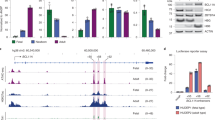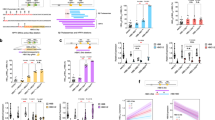ABSTRACT
HEL cells, a human erythroleukemia cell line, mainly express the fetal (γ)globin gene and trace amount of the embryonic (ɛ)globin gene, but not adult (β) globin gene. Here we show that hydroxyurea (HU) can induce HEL cells to express adult (β) globin gene and lead these cells to terminal differentiation. Results showed in Gel mobility shift assays that GATA factors could specifically bind to the regulatory elements of human β- globin gene, including the proximal regulatory element (the β- promoter) and the distal regulatory elements (the DNase I hypersensitive sites in the LCR, HS2-HS4 core sequences). However, the DNA binding patterns of GATA factors were quite different between HU-induced and uninduced HEL cells. Western-blot analysis of nuclear extracts from both the uninduced and HU- induced HEL cells revealed that the level of GATA-2 transcription factor decreased, whereas the level of GATA-1 transcription factor increased following the time of hydroxyurea induction. Furthermore, using RT-PCR analysis the expression of human β-globin gene in HU-induced HEL cells could be blocked again when HEL cells were incubated in the presence of antisense oligonucleotides for hGATA-1, suggesting that the upregulation of hGATA-1 transcription factor might be critical for the expression of human β-globin gene in HU-induced HEL cells.
Similar content being viewed by others
Log in or create a free account to read this content
Gain free access to this article, as well as selected content from this journal and more on nature.com
or
Abbreviations
- HU:
-
hydroxyurea
References
Rodgers GP, Dover GJ, Noguchi CT, Schechter AN, Nienhuis AW . Hematologic responses of patients with sickles cell disease to treatment with hyroxyurea. N Engl J Med 1990; 322:1037–45.
Huang SZ, Ren ZR, Chen MJ, Xu HP, Zeng YT, Rodgers GP, Zeng FY, Schechter AN . Treatment of b-thalassemia with hydroxyurea (Hu). Science in China 1994; 37:1350–9.
Zon LI, Yamaguchi Y, Yee K, Albee EA, Kimura A, Bennett JC, Orkin SH, and Ackerman SJ . Expression of mRNA for the GATA-binding protein in human eosinophils and basophils: potential role in gene transcription. Blood 1993; 81:3234–41.
Romeo PH, Prandini MH, Joulin V, Mignotte V, Prenant, M, Vainchenker W, Marguerie G, Uzan G . Megakaryocytic and erythocytic lineages share specific transcription factors. Nature (London) 1990; 344:447–9.
Martin DI, Zon LI, Mutter G, Orkin SH . Expression of an erythroid transcription factor in megakaryocytic and mast cell lineages. Nature(London) 1990; 344:444–7.
Yamamoto M, Ko LJ, Leonard MW, Beug H, Orkin SH, Engel JD . Activity and tissue specific expression of the transcription factor NF-E1 multigene family. Genes Dev 1990; 4:1650–62.
Sposi NM, Zon LI, Care A, Valtieri M, Testa U, Gabbianelli M, Mariani G, Bottero L, Mather, C,. Orkin, S.H. and Feschle. C . Cell-cycle dependant initiation and lineage-dependent abrogation of GATA-expression in pure differentiating hematopoietic progenitors. Proc Natl Acad Sci USA 1992; 89:6353–7.
Leonard M, Brice M, Engel JD, Papayannopoulou T . Dynamics of GATA transcription factor expression during erythroid differentiation. Blood 1993; 82:1071–9.
Wilson DB, Dorfman DM, Orkin SH . A non erythroid GATA-binding protein is required for function of the human preproendothelin-1 promoter in endothelial cells. Mol Cell Biol 1990; 10:4854–62.
Zon LI, Mather C, Burgess S, Bolce ME, Harland RM, Orkin SH . Expression of GATA-binding proteins during embryonic development in Xenopus laevis. Proc Natl Acad Sci USA 1991; 88:10642–6.
Dignam JD, Lebovitz RM, Roeder RG . Accurate transcription initiation by RNA polymeraseII in a soluble extract from isolated mammalian nuclei. Nucleic Acids Res 1983; 11:1475–89.
Ausubel FM, Brent R, Kingston RE . Preparation of Nuclear and cytoplasmic extracts from mammalian cells. Short protocols in molecular Biology. 2 nd edition. New Yark: John Wiley and Sons press. 1992.
Bradford MM A rapid and sensitive method for the quantiation of microgram quantities of protein utilizing the principle of protein-dye binding. Anal Biochem 1976; 76:248–54.
Yan ZJ, Chen YD, Qian RL . Development stage-specific factors in the mouse hematopoietic tissues binding to the 5′-flanking cis-acting elements of human e-globin gene. Chinese Science Bulletin 1995; 40:778–83.
Huang SZ, Rodgers GP, Zeng FY, Zeng YT, Schechter AN . Diagnosis of thalassemia using cDNA amplification of circulating erythroid cell mRNA with the polymerase chain reaction. Blood 1991; 78:2433–7.
Grosveld F, van Assendelft GB, Greaves DR, Kollias G . Position-independent, high-level expression of the human beta-globin gene in transgenic mice. Cell 1978; 51:975–85.
Dhar V, Nandi A, Schildkraut CL, Skoultchi AI . Erythroid-specific nuclease-hypersensitive sites flanking the human beta-globin domain. Mol Cell Biol 1990; 10:4324–33.
Orkin, SH . Regulation of globin gene expression in erythroid cells. Eur J Biochem 1995; 231:271–81.
Li Q, Stamatoyannopoulos G . Hypersensitive site 5 of the human beta locus control region functions as a chromatin insulator. Blood 1994; 84:1399–401.
Stamatoyannopoulos, G . Human hemoglobin switching. Science 1991; 252:383.
Felsenfeld G . Chromatin as an essential part of the transcriptional mechanism. Nature 1992; 355:219–24.
Tang Y, Qian RL . HS3 of the mouse LCR. Chinese Science Bulletin 1997; 42:2090–3.
Pevny L, Simon, MC, Robertson E, Klein WH, Tsai SF, D'Agati V, Orkin SH, Costantini F . Erythroid differentiation in chimaeric mice blocked by a targeted mutation in the gene for transcription factor GATA-1. Nature(London) 1991; 349:257–60.
Fujiwara Y, Browne CP, Cunniff K, Goff SC, Orkin SH . Arrested development of embryonic red cell precursors in mouse embryos lacking transcription factor GATA-1. Proc Natl Acad Sci USA 1996; 93:12355–8.
Weiss, MJ, Keller G, Orkin SH . Novel insights into erythroid development revealed through in vitro differentiation of GATA-1 embryonic stem cells. Genes Dev 1994; 8:1184–97.
Tsai FY, Keller G, Kuo FC, Weiss M, Chen JZ, Rosenblatt, M Alt FW, Orkin SH . An early haematopoietic defect in mice lacking the transcription factor GATA-2. Nature 1994; 371:221–226.
Tsai FY, Orkin SH . Transcription factor GATA-2 is required for proliferation/survival of early hematopoietic cells and mast cell formation, but not for erythroid and myeloid terminal differentiation. Blood 1997; 89:3636–43.
Ikonomi P, Noguchi CT, Miller W, Kassahun H, Hardison R, Schechter AN . Levels of GATA-1/GATA-2 transcription factors modulate expression of embryonic and fetal hemoglobins. Gene 2000; 261:277–87.
Fraser P, Pruzina S, Antoniou M, Grosveld F . Each hypersensitive site of the human β-globin locus control region confers a different developmental pattern of expression on the globin genes. Genes Dev 1993; 7:106–13.
Acknowledgements
This work was supported by the National Natural Science Foundation of China (Grant No. 39893320 and 39870378) and the Foundation of the Chinese Academy of Sciences (Grant No. KJ982-J1-618).
Author information
Authors and Affiliations
Corresponding author
Rights and permissions
About this article
Cite this article
ZHANG, S., HE, Q., ZHAO, H. et al. Function of GATA transcription factors in hydroxyurea-induced HEL cells. Cell Res 11, 301–310 (2001). https://doi.org/10.1038/sj.cr.7290100
Received:
Revised:
Accepted:
Issue date:
DOI: https://doi.org/10.1038/sj.cr.7290100
Keywords
This article is cited by
-
Increased transcription in hydroxyurea-treated root meristem cells of Vicia faba
Protoplasma (2013)
-
The interaction between the human β-globin locus control region and nuclear matrix
Cell Research (2002)



